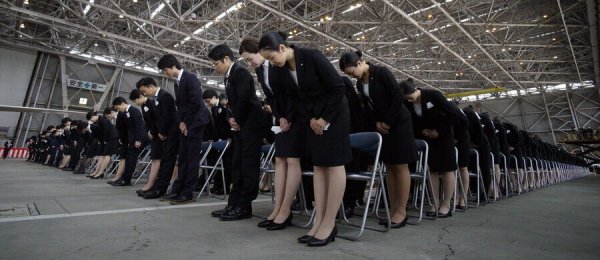Taijin Kyofusho, The Disorder of Fears


Written and verified by the psychologist Valeria Sabater
Taijin kyofusho disorder is a particular social phobia. It’s a social phobia that makes people scared of offending others somehow, either by saying something wrong, making the wrong gesture, or even by looking at them the way they do. As strange as this phobia might seem, it’s a textbook social anxiety disorder.
This specific disorder is linked to the Japanese people. As you probably know, the Japanese have high standards on correct behavior, absolute respect for others, and well-mannered courtesy. Also, it’s worth noting that this type of social phobia can manifest in any culture.
Taijin kyofusho disorder is rooted in self-doubt. This creates an obsession to be considered perfect. Thus, they want to look good, have the best attitude, or have the most outgoing personality. This makes people doubt themselves.
Similarly, things such as being ashamed of your stutter, saying something stupid, or having a bad odor are examples of the little things that make up taijin kyofusho disorder.
Taijin kyofusho disorder was first seen in Japan. However, in the Western world, this type of phobia has no category of its own. It’s classified among the other social phobias.

Characteristics and treatment for taijin kyofusho disorder
Taijin kyofusho disorder can be translated as “the disorder of fears”. This kind of phobia was first described in Japan. In Japanese culture, groups are more important than individuals. Thus, the fear of offending others is understandable.
This type of phobia can be seen elsewhere in the world. However, for the Japanese, it’s a well-known psychiatric syndrome. In the West, you barely hear anything about it. Although it doesn’t belong to any category, it’s a part of other specific and related obsessive disorders.
Differences between taijin kyofusho disorder and social anxiety
Although taijin kyofusho disorder is another type of social phobia, it’s worth noting a few things that make it special.
- People with social phobias worry a lot and feel ashamed and anxious when they’re in the presence of other people. However, patients with taijin kyofusho disorder fear to embarrass themselves or annoying other people just by existing.
- The main issue is not how people with this disorder react in a specific setting. They’re unsure of how others might react when they interact with them.
- Another interesting fact is obsessive-compulsive behavior. For example, there’s the case of an American woman diagnosed with this disorder. In a study conducted by the National University of Health Sciences in Chicago, this patient had a particular obsession: looking at other people’s genitals. She knew this was uncomfortable for them and, even though she felt anxious about it, she couldn’t stop staring.
These details show how complex this psychiatric disorder is.

Characteristics of taijin kyofusho disorder
This disorder has four subtypes that shape a specific type of phobia.
- Sekimen-kyofu. The fear of blushing and that other people feel uncomfortable about it.
- Shubo-kyofu. The fear of annoying others because you’re unattractive.
- Jiko-shisen-kyofu. Thinking others will feel threatened or uneasy if you look at them.
- Jiko-shu-kyofu. The fear of having foul body odor.
On the other hand, in the West, these four aspects are taken into account:
- Analyzing if these characteristics are permanent or transient. For example, this behavior can start in adolescence and then go away.
- How bad the phobia is.
- Having delusional, obsessive-compulsive thoughts, etc.
- This disorder is common in people with schizophrenia.
What are the treatments for this disorder?
From a cultural point of view, taijin kyofusho disorder can be very interesting. For example, the first treatment for this condition started in 1910, by Dr. Shoma Morita. Those days, this was the therapeutic approach the doctor used:
- Isolating the patient in a specific setting.
- Inviting them to rest and relax.
- Writing a journal.
- Doing manual work, such as gardening.
- Going to the lectures given by Dr. Morita.
From the 1930s onwards, Dr. Morita changed a few of these aspects. He introduced group therapy, as well as drug administration. Nowadays, the Japanese still use Morita therapy. In the West, things are different. Taijin kyofusho isn’t recognized as a separate disorder, so it’s treated as a social phobia.

There’s conductive cognitive therapy with exposure to triggers and self-esteem and relaxation techniques. However, it all depends on each patient and whether they have other disorders as well. Nevertheless, taijin kyofusho is well-known to the Japanese, not to the West.
Taijin kyofusho disorder is a particular social phobia. It’s a social phobia that makes people scared of offending others somehow, either by saying something wrong, making the wrong gesture, or even by looking at them the way they do. As strange as this phobia might seem, it’s a textbook social anxiety disorder.
This specific disorder is linked to the Japanese people. As you probably know, the Japanese have high standards on correct behavior, absolute respect for others, and well-mannered courtesy. Also, it’s worth noting that this type of social phobia can manifest in any culture.
Taijin kyofusho disorder is rooted in self-doubt. This creates an obsession to be considered perfect. Thus, they want to look good, have the best attitude, or have the most outgoing personality. This makes people doubt themselves.
Similarly, things such as being ashamed of your stutter, saying something stupid, or having a bad odor are examples of the little things that make up taijin kyofusho disorder.
Taijin kyofusho disorder was first seen in Japan. However, in the Western world, this type of phobia has no category of its own. It’s classified among the other social phobias.

Characteristics and treatment for taijin kyofusho disorder
Taijin kyofusho disorder can be translated as “the disorder of fears”. This kind of phobia was first described in Japan. In Japanese culture, groups are more important than individuals. Thus, the fear of offending others is understandable.
This type of phobia can be seen elsewhere in the world. However, for the Japanese, it’s a well-known psychiatric syndrome. In the West, you barely hear anything about it. Although it doesn’t belong to any category, it’s a part of other specific and related obsessive disorders.
Differences between taijin kyofusho disorder and social anxiety
Although taijin kyofusho disorder is another type of social phobia, it’s worth noting a few things that make it special.
- People with social phobias worry a lot and feel ashamed and anxious when they’re in the presence of other people. However, patients with taijin kyofusho disorder fear to embarrass themselves or annoying other people just by existing.
- The main issue is not how people with this disorder react in a specific setting. They’re unsure of how others might react when they interact with them.
- Another interesting fact is obsessive-compulsive behavior. For example, there’s the case of an American woman diagnosed with this disorder. In a study conducted by the National University of Health Sciences in Chicago, this patient had a particular obsession: looking at other people’s genitals. She knew this was uncomfortable for them and, even though she felt anxious about it, she couldn’t stop staring.
These details show how complex this psychiatric disorder is.

Characteristics of taijin kyofusho disorder
This disorder has four subtypes that shape a specific type of phobia.
- Sekimen-kyofu. The fear of blushing and that other people feel uncomfortable about it.
- Shubo-kyofu. The fear of annoying others because you’re unattractive.
- Jiko-shisen-kyofu. Thinking others will feel threatened or uneasy if you look at them.
- Jiko-shu-kyofu. The fear of having foul body odor.
On the other hand, in the West, these four aspects are taken into account:
- Analyzing if these characteristics are permanent or transient. For example, this behavior can start in adolescence and then go away.
- How bad the phobia is.
- Having delusional, obsessive-compulsive thoughts, etc.
- This disorder is common in people with schizophrenia.
What are the treatments for this disorder?
From a cultural point of view, taijin kyofusho disorder can be very interesting. For example, the first treatment for this condition started in 1910, by Dr. Shoma Morita. Those days, this was the therapeutic approach the doctor used:
- Isolating the patient in a specific setting.
- Inviting them to rest and relax.
- Writing a journal.
- Doing manual work, such as gardening.
- Going to the lectures given by Dr. Morita.
From the 1930s onwards, Dr. Morita changed a few of these aspects. He introduced group therapy, as well as drug administration. Nowadays, the Japanese still use Morita therapy. In the West, things are different. Taijin kyofusho isn’t recognized as a separate disorder, so it’s treated as a social phobia.

There’s conductive cognitive therapy with exposure to triggers and self-esteem and relaxation techniques. However, it all depends on each patient and whether they have other disorders as well. Nevertheless, taijin kyofusho is well-known to the Japanese, not to the West.
All cited sources were thoroughly reviewed by our team to ensure their quality, reliability, currency, and validity. The bibliography of this article was considered reliable and of academic or scientific accuracy.
- Essau, CA, Sasagawa, S., Chen, J., y Sakano, Y. (2012). Taijin kyofusho y síntomas de fobia social en adultos jóvenes en Inglaterra y en Japón. Revista de psicología intercultural , 43 (2), 219-232. https://doi.org/10.1177/0022022110386372
- Maeda, F., & Nathan, J. H. (1999). Understanding Taijin kyofusho through its treatment, Morita therapy. Journal of Psychosomatic Research. Elsevier Inc. https://doi.org/10.1016/S0022-3999(98)00113-5
This text is provided for informational purposes only and does not replace consultation with a professional. If in doubt, consult your specialist.







